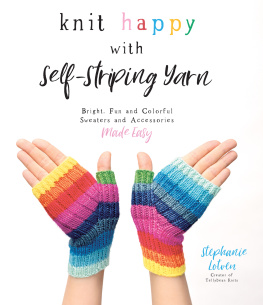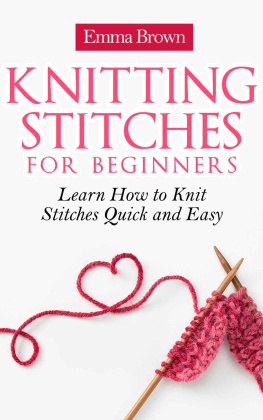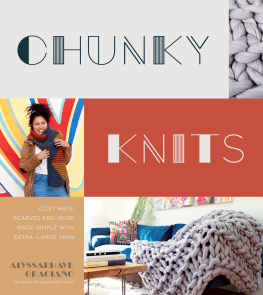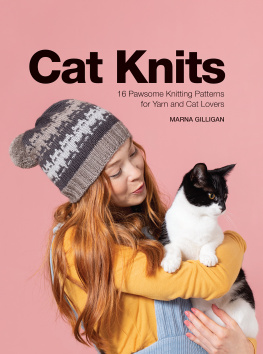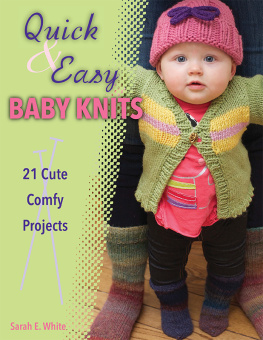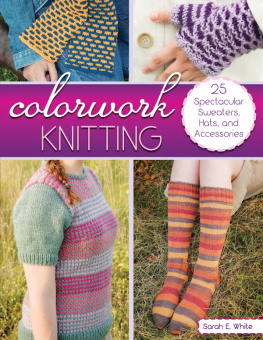Contents
Guide
Beginner
These patterns are appropriate for new knitters. They use knits and purls. There may be simple shaping using increases and decreases.
Adventurous Beginner
These patterns use repetitive stitch patterns, basic shaping and/or basic colorwork. Increases and decreases, bind offs and cast ons may be used for shaping. No short rows are used for shaping.
Intermediate
These patterns include cables, more complicated stitch patterns and more involved colorwork and finishing methods. Short rows may be used for shaping.
Advanced
These projects have the highest level of complexity. Expect to find patterns with complex colorwork, intricate short rows and specialty finishing methods. These projects are skill-heavy and include multiple referrals to special techniques.
What Is Self-Striping Yarn?
Self-striping yarn is dyed to create stripes at set intervals as you knit.
There are two types of self-striping yarn that you will see in this book:
Self-striping yarn with clearly defined stripes. The stripes knit from this yarn will be obvious and graphic. When one color ends, the next begins. The show examples of this type of self-striping yarn.
Self-striping yarn with a gradient. The stripes in this yarn will slowly transition from one color to the next, but there is still obvious striping. The Wave at the show examples of this type of self-striping yarn.
Narrow Stripes Versus Wide Stripes & Everything in Between
The size of a stripe knit with self-striping yarn is not universal. Yarns vary from brand to brand and colorway to colorway, so it is important to get to know your stripes before you choose a project.
The shorter the length of yarn in each color, the narrower the knitted stripes will be. The longer the length of yarn in each color, the wider the knitted stripes will be. The width of the stripe will be important when planning your project. Narrow stripes are best for patterns with small circumferences or fewer stitches per round/row. Mittens, for example, are a great project for narrow stripes. You will also find that several of the shawls, such as the are particularly fun projects for yarns with thick stripes.
The best way to decide if your yarn is right for a particular project is to swatch it.
Swatching
Knitters always hate to hear this, but swatching is important. You should do it. It will save your life! Okay, probably not your life, but it can certainly save your knitting project.
A swatch will give you essential insight into your yarn before you invest hours of work in a knitting project. Swatching will help you knit a garment that actually fits, avoid yarn chicken and inform you about the drape of the fabric your yarn can produce. When you swatch a self-striping yarn, you will gain another vital piece of information that will help you prepare for your project: how it will stripe.
Sleeves, hats, mittens, shawls and cowls are all worked with a different number of stitches. If you change the number of stitches, you change the size of the stripe. The more stitches you have in a row/round, the narrower the stripe will be. The fewer stitches you have in a row/round, the wider the stripe will be. The gauge will also change the way a yarn stripes. A larger gauge will use more yarn per stitch, making the stripe narrower. A smaller gauge will use less yarn per stitch, making the stripe wider. This is why you need to swatch! You simply wont know what your self-striping yarn is capable of until you knit a swatch for your project AT GAUGE. So, lets get swatching!
Step 1: Knit your swatch.
Knit your swatch just as you normally would when preparing for a new project. When you are finished swatching, blocking and drying your swatch, check to make sure that you have achieved the gauge specified in the pattern (see photo 1 on next page).
TIP: Unless the color repeat is quite long, I like to knit every color in the sequence at least once, so that I have a clear sense of the colors and the order of the colors in the yarn.
Step 2: Choose the narrowest stripe.
In some self-striping yarns, the stripes will all be the same size. In other yarns, the size of the stripes will vary. If the stripes are different sizes, choose the stripe that is the narrowest in the color sequence. If all the stripes are the same width, choose any stripe.
Step 3: Count your stitches.
Now, count all the stitches in your chosen stripe, and make a note of that number. This number tells you how many stitches you can knit in a single color of your self-striping yarn in order to create one complete row/round at gauge.
TIP: Do not count the stitches in the first stripe of your swatch. Cast-on stitches use more yarn than a typical stitch and will make your stitch count per stripe less accurate.
Step 4: Check the pattern.
Once you know the maximum number of stitches you can knit in a single color of your self-striping yarn, you can decide if it is right for your project. At the beginning of every pattern in this book, the Maximum Stitches Used for a Self-Striping Row/Round section will tell you the largest number of stitches you can expect to knit in that pattern using self-striping yarn, according to your size.
Step 5: Assess your stripe.
When I am knitting in self-striping yarn, my goal is to be able to work at least one complete ROUND or two complete ROWS in every color of the self-striping yarn. If your yarn is not able to achieve one complete round or two complete rows, the stripes might not look like stripes at all. A single color could fail to connect with itself and then the yarn may pool or look more like a variegated yarn.
Let me give you an example of how you will use this information for the patterns in this book. Lets say I am preparing to knit the in an adult size large. I have swatched my self-striping yarn, and I have achieved the appropriate gauge for the pattern. I have decided to count all the stitches in a single pink stripe, because it is my narrowest stripe, and find that I have 170 stitches in that stripe.
For my size, the pattern states that the maximum stitches used for a self-striping round is 80 stitches. I then divide 170 stitches by 80, which equals 2.1. This means that I can work just over two complete rounds in pink. This yarn is a good choice for an adult size large Rapid Run Hat. High five!
Identifying color repeats in a self-striping yarn.

